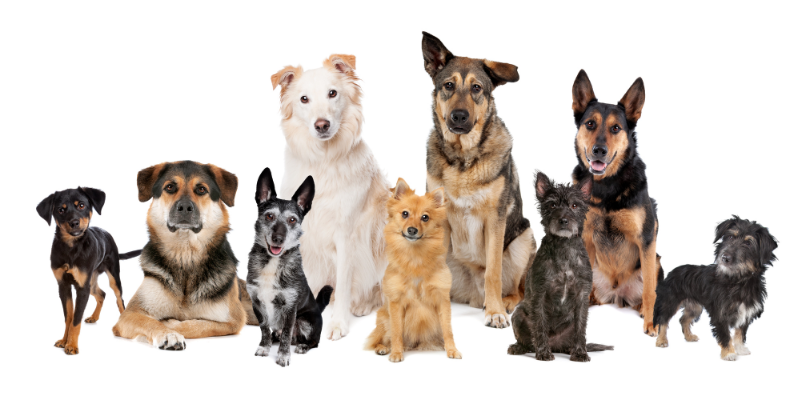PET OWNERSHIP STATISTICS:
Can’t Miss Stats You Should Know Before Getting Your First Dog
There’s no denying that a wagging doggy tail, happy eyes, and loving yips and licks make every day better.
If you aren’t a dog parent yet, there’s a fluff out there just waiting for a good, loving home. If you want your home to be that home, you’ll need to consider these pet ownership statistics and make sure you can take on the responsibility!

Table of Contents

Pet Ownership Statistics
When looking for the right dog to join your family, it’s important to look deeper than the puppy dog eyes and beautiful fluff.
In the interest of giving you a well-rounded, informative guide to getting your first dog, we’ve included a bunch of pet ownership statistics in each section to give you the best insight into what owning a dog really entails.
If you’re the type who likes to crunch the numbers before making a decision, you’ll appreciate these pet statistics to help you along the journey to becoming a pet parent.
Even if you’re not the analytical type, some of these stats are eye-opening and may give you some food for thought.
Dog Owners
According to American Pet Products Association’s 2019/20 National Pet Owners Survey, just over 60 million households in the US own dogs, with almost 90 million pet dogs in total.
As you can tell, dogs are popular pets! We assume it’s because of those wagging tails, puppy dog eyes, and cuddlability.
But the fact is, they cost money and need love (just like a human!). Between 1994 and 2020, the amount of money spent on pets increased by a whopping 560%.
If you’re thinking of adding a fluffy pup to your family, we’ll be looking at every aspect of pet ownership and how much you can expect to spend (both in time and money) on each one.
Pet Care
The same survey referenced above reports that an astounding +-75 billion dollars was spent on pets in 2019!
This was made up of things like:
- Veterinary Checkups
- Surgical Vet Visits (the largest chunk)
- Pet insurance
- Medication
- Dog Food
- Treats
- Vitamins & supplements
- Toys
- Grooming
- Boarding
We’ll delve into each one in a bit more detail so you can get a solid idea of what you can expect.
Veterinary Care
At some point, your dog will need to go to the vet. There’s no ifs and buts here! It’s likely that your first vet’s visits will be for vaccinations, followed by spaying or neutering.
1) Spaying/Neutering
Around 85% of pet dogs in the US are spayed or neutered. Although there’s some controversy around
whether or not it’s ethical, the facts are clear:
- Dogs who are spayed or neutered live longer.
- Marking territory is decreased.
- 32 US states require shelter dogs to be sterilized when adopted.
- You can be fined for having an intact dog.
The cost for spaying or neutering your dog differs depending on where you’re looking. Low-cost clinics are usually cheaper than veterinary hospitals, but it’s up to you where you feel comfortable taking your dog.
The price can range from $60 to $500, and bear in mind that it usually encompasses an examination, anaesthesia, surgery, post-op monitoring, medication, and post-op procedures like suture removal.
2) Medical Conditions
Common conditions include:
- Hypothyroidism
- Seizures
- Joint dysplasia
- Autoimmune disease
- Liver disease
- Urinary problems
- Heart conditions
Even if your dog is lucky enough not to suffer from any of these, other medically-related things often rear their heads even if your dog is mostly healthy.
Of course, there’s no way to estimate how much these things could cost. But certain conditions could have your dog on meds for life, while others will be a quicker fix.
Either way, when planning on getting your first dog, you need to be aware that any medical conditions he or she comes with is part and parcel of being a dog parent!
3) Emergencies
You’ll also need to be aware that dog emergencies happen! Whether your pup eats something it shouldn’t or is injured in a fight with another dog, you’ll need to be prepared.
One of the best ways to be prepared for all of the above is by taking out pet insurance.
Pet Insurance
Pet insurance has become a must, with many pet owners sharing stories of how their dogs overcame serious illness or injury thanks to their coverage.
The North American Pet Health Insurance Association (NAPHIA) reported that the number of pets insured in North America rose by 16% in 2019, to a total of around 2.8 million pets.
Of those almost 3 million pets, 83% are dogs!
If you’re going to become a dog parent, it’s certainly worth looking into, and by all accounts, well worth the money spent.
Dog Food, Vitamins, & Supplements
The average volume of dog food per person in 2020, according to Statista, is 39.1 kg. That might not sound like much but when you consider that most dogs belong to families of 3 or more people (ie. not every person is going to be buying dog food), that number increases exponentially.
Your pup is going to need to eat! Not only that, but they’re going to need to eat decent food. Unfortunately, most commercial dog foods aren’t as healthy as they appear.
Here at Dog Embassy, we’re committed to bringing you only the best dog foods. You’re welcome to browse through our dog food reviews to find the best kibble for your dog!
In terms of pet ownership statistics, by 2018, 40.% of households were feeding their pets wet or canned food. It’s not clear whether this is on its own, or in addition to dry kibble.
We recommend choosing dry kibble or fresh food, but keeping canned food for occasions when your pet may need extra calories or be unable to crunch hard food.
Toys & Accessories
Pups are super at entertaining themselves when they’re bored. The problem is, most of their ideas of entertainment end up with a chewed-apart shoe or a scratched up sofa!
You’ll have to stock up fully before bringing your pet home so there’s as little chance as possible of these things happening. Here’s what you’ll need:
- A dog crate & tray (if you’re planning on crate training or potty training)
- Chew toys
- Puzzle toys (great for dogs who are food motivated)
- Dog gates (possibly, to block off certain areas of the house)
Other accessories that you’ll need whether or not your dog is a chewer, include a dog bed, blankets, food and water bowls, collars/harnesses and leashes, shampoo, and a brush.
Grooming
Depending on what dog breed your fluff is, they could need almost no grooming at all, or they could require a complete de-fluff every few weeks.
If you’re planning on getting a longer-haired breed like an Australian Shepherd or a Cocker Spaniel, you can expect to spend more on grooming than if you were bringing home a short-haired breed like a Doberman or a Dachshund.
It’s up to you whether you choose to get your dog groomed by a professional or do it yourself. Either way, you’ll be spending money (and time, if you DIY).
Boarding
If you spend a lot of time away from home, you may need to consider boarding your dog while you’re away. If you have family or friends who can pet-sit, that’s a bonus! But if you don’t, you’ll have to consider the options.
Time Expenses
As you can tell, being a dog parent can be fairly pricey! If you’re confident you can deal with all that and be able to support a dog, the next thing to consider is how much time you’d need to spend with your pup.
The following things aren’t necessarily going to cost you money. But they’ll definitely take some time, and if you’ll be unable to provide that, then dog ownership may not be for you.
Exercise
Even if you have a large backyard, dogs need to be taken for a walk every day (or every other day, at least).
Exercise is paramount to keep dogs fit and healthy. According to 2018 data, 55.8% of dogs in the US are overweight, with 18.9% of them being obese! That’s no life for a dog.
If you can’t commit to at least a few walks a week and plenty of wrestling and romping in between, then a cat may be the best pet for you!
Training
Training is often neglected, and it can have disastrous results. Only 4% of dogs (and owners) attend training classes, but they’re not a necessity – you can train your dog from home with just some time and patience.
Whichever way you choose to train, you’ll need to set aside some time. You can’t just drop your dog off at class and go run errands!
You’ll need to be actively involved in the process, and it will require you to keep up with training outside of classes too. Thankfully, once dogs are trained they’re pretty good at remembering that training. So you shouldn’t need to keep training your pup for years!

Adopt or Buy?
If you’ve read through all of that and you’re still pretty sure you want to be a dog parent, awesome! Now we get to the fun stuff – how to choose the right dog for you!
The first decision you’ll make is whether to adopt a dog or buy a dog from a breeder.
Adoption Statistics
According to the ASPCA, 3.3 million dogs end up in shelters every year. Of those, around 20% are euthanized.
The good news is that about 600 000 of these dogs are reunited with their owners after getting lost.
The bad news is that the rest of them never find their parents again, or are brought to shelters because of:
- Aggression
- Health problems
- Unexpectedly large size
- No time to spend with a pet
- Chewing/digging
- Owners moving house
- The cost of keeping a pet
Ultimately, it’s your choice whether you adopt or buy. There are some advantages and disadvantages to each, which we’ll discuss further down.
Here at Dog Embassy, we’re advocates of adoption!
Pros and Cons of Adopting
There are thousands of dogs out there waiting for loving pet parents. You could be that person who gives a pup a new life.
To give you a well-rounded idea of adoption vs buying, here are some positives and negative to adopting a dog:
Pros
- Generally more affordable than buying
- It’s easier to find specific breeds, given the vast number of dogs in shelters
- There’s a possibility of getting a dog that’s already spayed or neutered
- The shelter may vaccinate your pooch for you
- Wider choice of different life stages
- That saving-a-life thing!
Cons
- You won’t know if the dog has underlying medical conditions
- Behavioral problems may surface (due to their previous life or trauma)
Where Are You Adopting From?
Every dog in every shelter needs a home. Do some research on shelters near you. Make sure the shelter looks decent and treats their animals well.
Do a bit of research on what pets are available in your state. Here are some resources you may find useful:
What’s the Dog’s Background?
Get as much info as you can when choosing a dog from a shelter. Check what health condition the pup was when they arrived at the shelter, and if they’ve been treated for anything from skin conditions to full-blown diseases.
Having an idea of possible medical conditions will give you a bit of insight into what you may be spending time and money on in the future.
Be aware that if you have kids, bringing home a dog with an unknown background could be problematic. You’re unsure if the pup has had bad experiences with kids before, and the risk may be too great of a child being bitten.
The best way to gauge how the pooch deals with kids is to have a playdate at the shelter. The second most important thing is to teach your kids to always treat a dog with respect and love!
What Medical Procedures Does It Need?
It’s a bit of a lottery when adopting a dog. You never know whether they’ll be sterilized already or not, and if the pup you choose isn’t, you’ll be required by law in many states to have it done.
Many shelters will do vaccinations for you as part of the adoption process.
How Much Does it Cost to Adopt a Dog?
Yes, you’ll still need to pay a fee when adopting a dog. But these adoption fees go towards taking care of animals in shelters, and go a long way towards reducing the number of animals who have to be euthanized.
Pet adoption fees vary depending on many things, such as:
- Local laws
- Public or private shelter
- Dog breed
- Dog’s size
- Whether it’s sterilized or not
- Whether it’s vaccinated or not
Your fee could be small if the dog you’re adopting is already sterilized, vaccinated, and in generally good condition.
If the shelter needs to vaccinate, spay or neuter a pet you can expect the fee to be a little higher. In some cases, shelters provide things like collars, tags, and microchips, and as can be expected, each of these things will add to the adoption fee.
What To Consider When Buying
There are two ways to go when buying a dog – go to a pet store or a breeder. Both of them can go horribly wrong; if you find a store that’s running a puppy mill, or a breeder that’s cross-breeding or over-breeding.
But if you find a high-quality store or a breeder with a great reputation, they’d be good places to look for your first dog.
Keep in mind that if you’re looking for an adult dog instead of a puppy, they could be harder to find at a store or breeder.
Pros
- Breeders should provide a purebred certificate.
- Your dog’s lineage should be traceable (using their papers).
- It’s easier to foresee any possible medical conditions.
- The pup you buy should be vaccinated by the breeder.
Cons
- Buying a dog can come with a higher price tag than adopting.
- Pet stores and puppy mills may be cheaper, but you’ll be supporting an horrendous industry.
- You’ll most likely need to do more research in order to find a decent breeder.
- It could be harder to find specific breeds and life stages other than puppies.
Where Are You Buying From?
Don’t just buy a puppy from anywhere. Do you research! Check out these resources to find a reputable breeder:
- American Kennel Club Marketplace
- USDA
- American Dog Breeders Association
- Visit local dog shows
- Get a referral from a veterinarian
What’s The Dog’s Background?
When buying a dog from a breeder, a large advantage is having some insight into potential health conditions based on the puppy’s parents.
If you have an idea of what medical conditions could be an issue, you can get a headstart on prevention and prepare for the possibility of needing meds or surgery in the future.
When buying from a breeder, if he’s selling purebreds you should be able to get papers proving your dog’s lineage.
What Medical Procedures Will The Dog Need?
Breeders may vaccinate your puppy for you, but it’s likely you’ll need to sort out sterilization on your own. Other vaccinations that come with a growing pup will be your responsibility to remember and book.
How Much Does it Cost to Buy a Dog?
Buying a dog can cost hundreds or even thousands of dollars. Remember, you’re most likely getting a purebred or a designer crossbreed, so prices can get quite hefty depending on the actual dog.
Why Should You Adopt a Pet Rather Than Buy?
The fact is, by adopting a shelter dog you could be literally saving the fluff’s life. If every new dog parent adopted a dog from a shelter instead of buying, those 3 million plus dogs in shelters would all get to experience the love of a good home!
If you’re looking for a tangible fact to go on (apart from the multitude of happy loves and cuddles you’ll be getting and the undying loyalty) consider that adopting is usually more affordable than buying.
The only time we’d recommend buying over adopting is if you have kids and you need a dog that’s fairly guaranteed to be kid-friendly. In that case, the risk of your adopted dog having underlying behavioral issues and lashing out in fright or as a reflex is too great.
Choosing to buy, in this case, means you can raise a puppy with your children and come much closer to guaranteeing a safe environment for both.
Apart from that particular situation, we always advocate adopting! Dogs know when they’re saved, and although there may on occasion be some underlying trauma, you’ll have the devoted love and never-ending loyalty of the pup you rescued.

Choosing The Dog For You
Now that you’ve made sure you can afford a dog, and you’ve decided whether to adopt or buy, all that remains is to choose your perfect match!
There are 2 things to consider here: the age of the dog, and the dog breed.
Life Stage
Just because you’re getting your first dog, it doesn’t mean you have to get a puppy. Of course, puppies are adorable! But they’re also high-maintenance, and adult dogs and seniors need homes just as much as little ones do.
Puppy
If you’re planning on buying a dog, chances are you won’t find adult dogs easily. Puppies, though, won’t be difficult to find. Pet stores and breeders offer a variety of breeds, and puppies are the first to be adopted at shelters.
Puppies are great for families with kids as the children and dogs can grow up together and learn mutual respect and love for one another. Also, a puppy is a superb way to teach your child some responsibility!
Puppies are ideal for families or couples of whom one spends most of their day at home. They’ll need to be fed three to four times throughout the day, as well as potty-trained from an early age. You can’t do that if you’re not there!
They’ll also require puppy-specific food, and things like puppy pee pads and plenty of toys to chew on.
Adult
You’re unlikely to find an adult dog at a breeder, but shelters are full of them. Many of these dogs have lived with a family before. One of three scenarios is usually true:
They got lost and ended up at the shelter as a stray. They were surrendered to the shelter by their previous family. Puppies were born to stray dogs and have always lived on the streets.
Whichever of these cases is true, adult dogs at shelters have a bit of trauma and a lot of sadness and confusion.
Most of them will be absolutely overjoyed to find another family. When adopting an adult dog, you do run the risk of uncovering bad behaviors. You don’t know if the dog you’re adopting likes to dig or chew, or if they’re terrified of loud noises, or have bad experiences with children, or men, or cats.
Often, these are things you only find out later! But with some love and patience, most adult rescue dogs turn out to be lovable, loyal, and perfectly cuddly pups.
Many adult dogs will already be sterilized, and if they aren’t, the shelter should do it for you. In terms of food, your choices for adult dogs should be much wider. As long as you’ve chosen a reputable, healthy brand (see our section up above on dog foods!), your adult rescue should thrive.
Senior
Seniors are the most at-risk for euthanasia in dog shelters. When shelters become over-crowded and need more space, the “least adoptable” pets are the most unfortunate ones.
The sad reality is that most people don’t want to adopt a dog that only has a few years left of life. We want companions for a decade!
Senior dogs, though, want a loving, comfortable spot to rest in for their last few years. They’re typically much less maintenance than young dogs, and you won’t need to exercise them as much or feed them as much.
You may need to buy a senior-specific food, or give them joint supplements in addition to their kibble. If the senior you choose has bad teeth, you might need to stick to wet foods instead of dry kibble, but be sure to go for a quality option like The Honest Kitchen or make fresh food yourself.
If you’re serious about the companionship side of getting a dog, please, consider adopting a senior! These older fluffs need just as much love as the young ones, if not more, as they navigate their last years.
You’ll need patience, but you’ll get a loving, loyal, and most likely fairly relaxed pooch.
Which Breed Should I Go For?
Now we’re getting down to the details. You’ve considered whether or not you’ll be able to afford a dog. You’ve decided whether adopting or buying would be best. Hopefully, you’ve considered all life stages and made a great choice.
All that’s left is to choose a breed! Keep in mind, though, that there’s no guarantee of finding your chosen breed at a shelter. If you’re going through a breeder, you’ll have to find the right breeder for the breed you want.
For interest’s sake, here are the top 5 most popular dog breeds in the US in 2019:
The breed you choose may be as simple as a breed you’ve always loved, or the same breed you had while growing up. But you may want to consider certain breeds over others in particular situations; for example, if you have kids, if you’re looking for a guard dog, or if you want a pup who’s active enough to keep up with your exercise routine.
Kid-Friendly
If you’ve got little ones, it’s imperative that you choose a breed that has a good reputation as a child-friendly dog. Here are the top choices:
- Spaniels
- Golden Retrievers
- Beagles
- Labradoodles
- Boxers
Guard Dog
Perhaps you’re on the hunt for a dog who can protect you as well as be your buddy. Here are some dog breeds who would make great watch dogs:
- German Shepherds
- Boerboels
- Doberman Pinschers
- Rottweilers
- Staffordshire Terriers
Exercise Buddy
If you’re a fan of the active lifestyle and would prefer a dog who can keep up with your exercise regime, these pups are the fitness enthusiasts of the dog world!
- Huskies
- Border Collies
- Belgian Malinois
- Dalmations
- Jack Russells
Chilled Companion
Maybe you simply want a fluffy, cuddly companion to chill with you on the sofa and binge-watch series. Here are the most relaxed pups out there.
- Bulldogs
- Pugs
- English Mastiffs
- Great Danes
- Pekingese
Deal Breakers
Before heading out to pick up your new pup, it’s wise to decide on some traits that could be deal-breakers. Things like:
- Not socialized
- Not potty trained
- Bad with children
- Destructive chewing
- Separation anxiety
… could be bigger problems down the line. Not all of these things will be able to be fixed, and some bad habits may pop up again years down the line even after training.
Also, if you already have cats, birds, or fish, a dog with a hunter’s instinct is probably not a good idea!
Final Choice
You’re reaching the end! Once you’ve pinpointed the dog you want and made sure you’ll be able to afford looking after it (time and money-wise), make sure you’re familiar and okay with their:
- Energy requirements
- Common health conditions
- Nutritional requirements
- Coat condition & shedding
- Attitude towards humans, cats, and other dogs
If your pup has figured out how to open trash can lids and toilet seats, you’ll need to be a little more creative in figuring out how to keep these down. Latches, hooks, and duct tape are all useful options!

House Rules
If you’ve made it this far and you’re getting ready to bring your new pooch home, congratulations! This is an exciting time in your life, but I can guarantee your new family member is even more overjoyed than you are.
Remember, your new addition might be so excited he forgets this is your house, your rules! You’ll need to enforce discipline so he learns what he’s allowed to do and what he isn’t.
Of course, discipline needs to be undertaken with patience and love!
What’s Allowed and What’s Not?
Decide what’s allowed and what’s not before you bring your new pup home. Setting behavioral expectations is essential from day one! The sooner your new dog gets into a habit or routine, the easier it will be for everyone to adjust to this new life.
If you aren’t too sure, consider the following things:
- Allowed on the sofa or not?
- Are there areas in the house/garden they shouldn’t go?
- Where will he or she sleep?
- Doggy daycare or free run of the house?
- Who takes the dog for a run? Is there a specific time of day?
- Where should the pup be when the humans are eating?
You should have specific ideas for each of these situations, and from the moment the new pup sets paw in your home, you’ll need to show him/her the way.
This is like new-home training. Positive reinforcement is always the best way to make it stick!
Potential Problems
It can be all blissful and loving, bringing your new buddy home and welcoming him or her to the family. Just like a blossoming romance, the first few months are likely to be filled with fun, joy, and a bunch of adorable moments.
But it’s entirely possible that you spot some strange behaviors popping up as time goes on. Remember, your dog had a whole life before you came along, so there’s always a chance that they built some bad habits.
Destructive Behaviors
If you’ve been noticing teeth marks on the furniture, soil scattered around the yard, or gouges out of the wooden door, your new friend may have some destructive behavior habits. Some common ones are:
- Excessive chewing
- Digging
- Scratching
Usually, these behaviors are triggered by one of two things: stress or boredom. To reduce the chances of them behaving this way, fix the root of the problem!
Solution: If the reason is boredom, get your pup a chew toy for stimulation or a puzzle toy to keep them busy. If the source is stress, remove what’s causing the stress. If you’re not sure, a vet’s visit may be in order.
Separation Anxiety
This one can be tougher to deal with. It’s entirely possible that your fluff has been traumatized by being left at a shelter and worries that he may be abandoned again, this time by you.
Separation anxiety is driven by fear. Actually, you may never see the effects of separation anxiety, and it can be quite hard to pin down as it usually pops up when you’re not there.
But if you have an idea that it could be a problem or if you’ve used technology to your advantage and set up a camera and found it to be an issue, it needs addressing straight away.
Solution: You’ll need to work on this a bit before your dog begins to understand that it’s okay for you to leave. Try these few things to lessen the effects of his/her separation anxiety:
- Don’t make a fuss when leaving the house or coming back.
- Give your pup a chew toy to relieve her anxiety before slipping out the door.
- If you can, leave the radio or TV on for background chatter.
- Leave a shirt, hoodie, or sock with your pup so your scent is nearby and he’s comforted.
Begging
If you’ve discovered that your new fluffy soulmate is a beggar, you need to understand that beginning for human food is a learned behavior. It’s entirely possible that he was allowed to beg or was even fed off the plate in his last home.
It’s important that you don’t punish a dog for this, especially if he’s an adult rescue dog. Guide him gently to show him how to behave, but positive reinforcement always wins!
Solution: Sit your pup down at a short distance from the table, and make sure they know that that’s their waiting spot. If they sneak closer, remove them to their waiting spot again. Use a strong “Stay” command. If they obey, and stay put for the whole meal, give them a treat.
Going In The House
Yes – peeing or pooping. If your new puppy is going where they shouldn’t be, it’s because they don’t know any better! They’ll need some training to either go outside or in their crate.
If your adult dog has suddenly started doing their business in the house, it’s likely to be an indication of a deeper issue. Has something sparked anxiety in your dog? Some common triggers include separation anxiety, a change of environment (like moving house), or something else that’s causing them stress.
In severe cases that have no apparent cause, a trip to the vet may be warranted to exclude medical reasons.
Solution: If training isn’t the problem, you’ll need to figure out what it is. If you fix the root of the problem, your dog should be a-okay to start going outside again. Make sure he/she gets enough time outside, too.

Wrapping Up
Pet ownership statistics typically show how much dogs are loved and appreciated. But there are still thousands of dogs out there waiting for a loving home and a human to call their own.
Some of the more devastating statistics include how many dogs are left in shelters because they aren’t cute puppies anymore, or because they chewed on furniture out of boredom.
Getting a dog is a commitment! You’re committing to providing life, food, and love for this fluff, and you need to make sure you’re 100% ready for that, and for the reality of owning an adult pooch, before getting your first dog.
If you’re planning on becoming a pet parent, we always advocate adopting over buying! While purebred pups need good homes too, those who find themselves in shelters are in a life or death situation.
Happy adopting!




